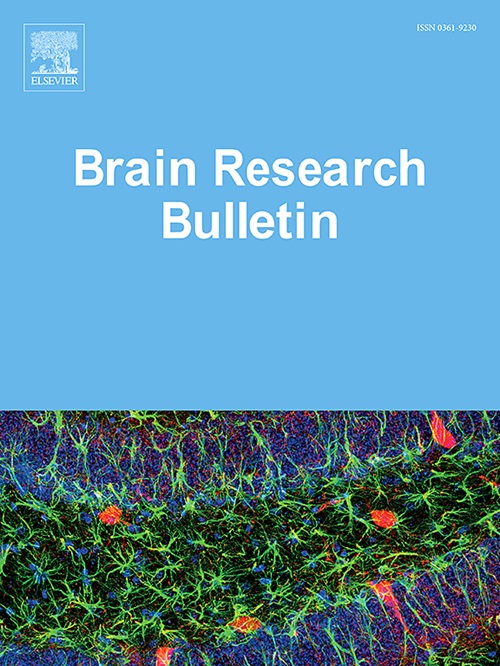太赫兹辐射通过降低膜面积比来影响神经元的动力学
IF 3.7
3区 医学
Q2 NEUROSCIENCES
引用次数: 0
摘要
特定频率和能量的太赫兹辐射可以通过激发蛋白质或DNA中的非线性共振效应来介导细胞形态或功能的变化。然而,太赫兹辐射对神经元形态和功能的影响目前尚不清楚,太赫兹辐射后神经元形态和动力学性质之间的关系仍有待阐明。在本文中,我们首先通过神经元胞浆与突起膜面积的相对比例来表征神经元形态的变化。分析了太赫兹辐射对神经元形态的影响规律及累积效应。在此基础上,本文构建了太赫兹辐射调控神经元的动力学模型,研究了太赫兹辐射对神经元动力学特性的影响规律,并分析了神经元形态与动力学特性之间的相关性。结果表明,太赫兹辐射导致神经元胞浆与突起的膜面积比下降,这种影响从太赫兹辐射第一天开始,一直持续到太赫兹辐射结束;太赫兹辐射通过降低神经元胞浆与突起的膜面积比,降低神经元簇间放电频率和动作电位振幅,增加神经元簇内放电,从而改变神经元放电模式。此外,太赫兹辐射可以通过降低膜面积比来增加神经元突触后电流的峰值。综上所述,太赫兹辐射可以通过影响神经元的形态来调节神经元的形态,改变其放电模式和动力学性质。这些预测,特定频率和能量的太赫兹辐射可以作为一种新的,分子水平的神经调节技术,用于干预或治疗神经元退行性疾病。本文章由计算机程序翻译,如有差异,请以英文原文为准。
Terahertz radiation affects the dynamics of neurons by decreasing membrane area ratio
Terahertz radiation at specific frequencies and energies can mediate cellular morphology or function changes by exciting nonlinear resonance effects in proteins or DNA. However, the effects of terahertz radiation on neuronal morphology and function are currently unknown, and the correlation between neuronal morphology and kinetic properties after terahertz radiation remains to be elucidated. In this paper, we first characterized the changes in neuronal morphology by the relative ratio of neuronal cytosol to protruding membrane area. Analyzed the pattern of the influence of terahertz radiation on neuronal morphology and the cumulative effect. On this basis, this paper constructs a kinetic model of neurons regulated by terahertz radiation, investigates the influence law of terahertz radiation on the kinetic properties of neurons, and analyzes the correlation between neuronal morphology and kinetic properties. The results showed that terahertz radiation caused a decrease in the membrane area ratio of neuronal cytosol to protrusion, and this effect started on the first day of terahertz radiation and lasted until the end of terahertz radiation; terahertz radiation changed the neuronal discharge pattern by decreasing the membrane area ratio of neuronal cytosol to protrusion and lowered the frequency of neuronal inter-cluster discharges and amplitude of action potentials, and increased the neuronal intra-cluster discharge. In addition, terahertz radiation can increase the peak value of neuronal postsynaptic currents by decreasing the membrane area ratio. In summary, terahertz radiation can modulate neurons' morphology and change their firing patterns and kinetic properties by affecting their morphology. These predict that terahertz radiation at specific frequencies and energies can be developed as a novel, molecular-level neuromodulation technique for intervening or treating neuronal degenerative diseases.
求助全文
通过发布文献求助,成功后即可免费获取论文全文。
去求助
来源期刊

Brain Research Bulletin
医学-神经科学
CiteScore
6.90
自引率
2.60%
发文量
253
审稿时长
67 days
期刊介绍:
The Brain Research Bulletin (BRB) aims to publish novel work that advances our knowledge of molecular and cellular mechanisms that underlie neural network properties associated with behavior, cognition and other brain functions during neurodevelopment and in the adult. Although clinical research is out of the Journal''s scope, the BRB also aims to publish translation research that provides insight into biological mechanisms and processes associated with neurodegeneration mechanisms, neurological diseases and neuropsychiatric disorders. The Journal is especially interested in research using novel methodologies, such as optogenetics, multielectrode array recordings and life imaging in wild-type and genetically-modified animal models, with the goal to advance our understanding of how neurons, glia and networks function in vivo.
 求助内容:
求助内容: 应助结果提醒方式:
应助结果提醒方式:


